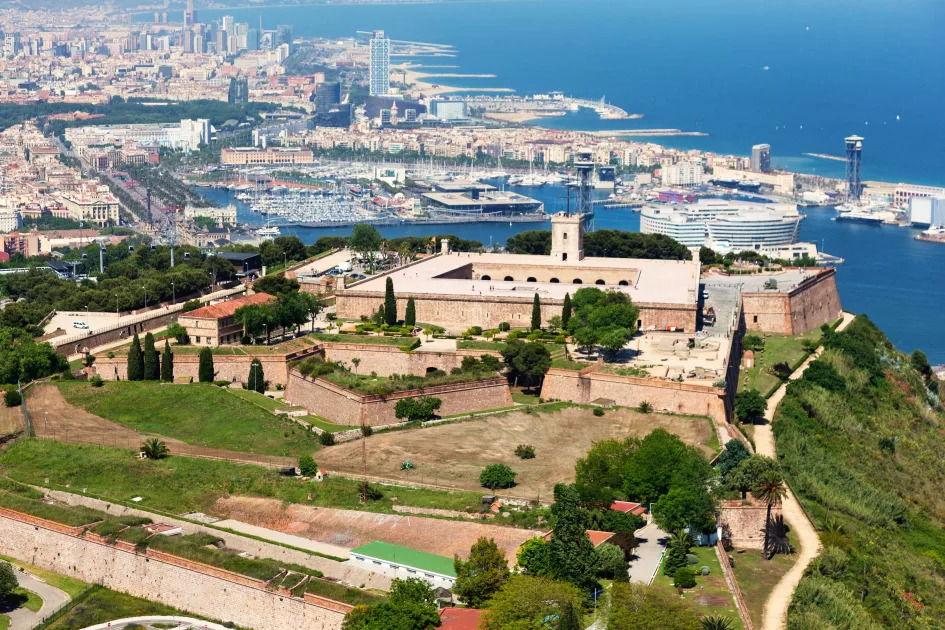
If you are not passing through Barcelona and have more than one day for sightseeing, you must visit Montjuic (Montjuïc). This green hill, 173 metres above sea level, used to be an observation post and a very important defensive centre of the city. Nowadays, it is considered one of the most famous tourist attractions in Barcelona, with a special, sometimes medieval atmosphere.
Things to do in Montjuic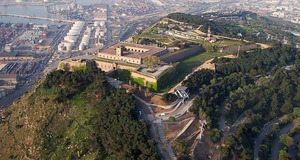
Here you can spend hours strolling along the paths and admiring the rich cultural heritage left to us by many generations. It's not just tourists who climb Montjuic - it's also one of the locals' favourite places to meet and relax. After all, there are so many colourful sights on this hill!
It is recommended to start from the top of Montjuic from the top down (starting from the fortress and ending at the National Museum of Art of Catalonia), so that you can see all the sights of Montjuic in order as you make your way down the mountain.
Castle
On the highest point of the mountain stands the Montjuic Castle, a fortification that once played an important role in Barcelona's history. The building dates back to 1640. Castle was used not only for defensive purposes, but also for bombardment. In 1842, the cannons of the fortress were aimed at the city to suppress a revolutionary uprising. Later the building was used as a prison.
The history is very interesting and informative - as is everything about the magnificent Barcelona! The Castle is free to visit every Sunday from 15:00 and all day on the first Sunday of the month. The rest of the time there is a charge for admission to the castle - adults 12 euros, children under 8 years old are free of charge.
How to get to Montjuic Castle
Bus 150 from Plaza España takes you 20 minutes to Montjuic Fortress. It goes all the way round the hill and stops at many of the mountain's sights.
The funicular will also get you there pretty quickly. At the Paral-lel metro station (L2 and L3 lines), without leaving the metro, take the funicular, which is integrated with the same metro ticket.
The tourist bus is also a very good option. It stops near Barcelona's sights, and Montjuic is no exception. The bus will take you to the Montjuic cable car, from where you can take it to the castle.
If you're by car, driving is allowed here and free parking is available near many attractions.
Slides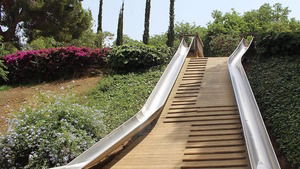
After visiting the fortress, families with children will be interested in going through the place, especially since the Montjuic slides are just on the way down from the top of the hill. Two large slides that will be fun to ride not only for kids, but for adults too. There is also a children's playground and a relaxing bar nearby.
Alcalde Gardens and Viewpoint
Mirador de l'Alcalde. A small beautiful park with many trees, plants and flowers. There are interesting sculptures, ponds, cascading fountains. It is located just 10 minutes downhill from the Montjuic Castle.
It is simply impossible not to notice it. From the observation deck you can enjoy magnificent views of Barcelona and its sights. There are also benches and a kiosk selling drinks and snacks everywhere.
Mossen Costa and Llobera Gardens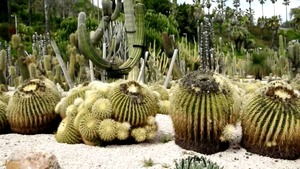
Jardines de Mossen i Costa i Llobera. After descending from the Montjuic fortress, looking towards the sea, there is a marvellous park on the southern slope of the mountain, where there are about 800 varieties of cacti and exotic plants.
It's usually quiet and offers great photo opportunities thanks to the excellent views of the Mediterranean Sea and Barcelona's harbour.
Joan Bross's garden (Jardines de Joan Brossa)
Barcelona has many different natural parks and the Joan Brossa Green Garden (named in honour of the Catalan poet) is one of them. Curiously enough, more than 30 years ago there was an amusement park on this site, of which only many statues remain. It is very interesting to walk along the numerous paths and paths, suddenly coming across another sculpture.
You can visit the park by going down from the Castle of Montjuic across the road, after the sculpture dedicated to Sardana (Sardana is a Catalan dance that is danced in a circle: people join hands and dance in a circle to the beat of a drum). There are signs everywhere, just make sure you follow the right direction.
Mossen Gardens Cinto Verdaguer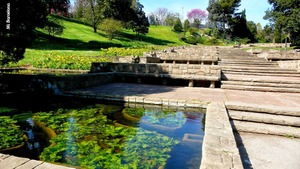
Jardines de Mossèn Cinto Verdaguer. Located next to the Joan Brossa Garden. It is considered one of the most beautiful and well-maintained parks in Barcelona. There are small ponds and a lake with flowering aquatic plants, a wooden bridge and several statues. People come here to picnic and relax in the natural silence. The park is especially beautiful in spring, when everything is covered with all kinds of flowers and there is an unforgettable aroma in the air!
Palace of Albéniz (Palauet Albeniz)
The official residence of the royal family in Barcelona. It is usually closed to the public, but there are also open days, such as 24 September. On this day, Barcelonans celebrate the arrival of autumn and its long-awaited coolness. Considered one of Barcelona's main festivals, which lasts for five days, is La Mercè.
Although it's not possible to get inside the palace, exploring the gardens surrounding it is a must-do if you're visiting Montjuic on certain days. They have a total area of around four hectares and are open to the public on Saturdays, Sundays and public holidays from 10:00 to 15:00. In different parts of this beautiful and elegant park there is a monumental fountain, an amphitheatre and interesting sculptures.
Laribal Gardens
Jardines de Laribal. A garden built on a hill with many steps, terraces, pergolas, paths, ponds and green vegetation. Josep Amargós originally came up with the idea of landscaping the Montjuic hill. This was at the end of the XIX century.
And now, thanks to his followers, the whole hill is covered in parks and gardens full of both ordinary vegetation and unusual and even exotic species. Laribal Gardens are no exception - here nature allows you to stop in the moment - just breathe, look, feel your unity with it. Stroll through the park in silence, away from the hustle and bustle of the city. What could be better?
Greek theatre
Located next to the beautiful Laribal Gardens. It is an open-air theatre. Despite being called a Greek theatre, this theatre was not built by the Greeks in ancient times.
In 1929, the Greek theatre was built on the site of an old quarry with a cut wall as a stage and stone seats for the audience, which seats 1900 people. Since then, the Grec festival, which includes theatre, concerts and dancing, is held here every summer. There are also beautiful gardens next to the theatre that are worth a visit.
Joan Miró Foundation (Fundació Joan Miró)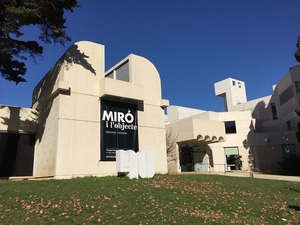
Museum of Contemporary Art in Barcelona. Joan Miró is one of the 20th century Catalan artists who made an invaluable contribution to art. His works can be seen not only in Spain, but also in many countries around the world. In the Miró Museum you will see more than 10,000 compositions - paintings, sculptures, sketches, carpets. The entrance fee is 15€, but children under 15 years old are free, which is nice.
Botanical Gardens
Another natural corner on the green mountain of Montjuic. Flowers and plants from different parts of the world are gathered here. This oasis of tranquillity is filled with the scents of a variety of flora. As you stroll through each section of the park, you are transported to different regions where the amazing plants that belong to them grow. It is located next to the Olympic Stadium.
The sign for the entrance to the Botanical Gardens is pre-marked on a stand on the road next to the car park, just look around and you'll see it. There is a charge of €3.5 to visit.
Historic Botanical Gardens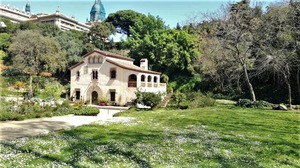
Strange, but this amazing place is not very visited by tourists. The park has an interesting history and was first built in the middle of the last century.
The temperature here is 4ºC lower than in the neighbourhood because of its location inside a ravine formed by an old quarry. The tallest trees in Barcelona grow here! There is a small waterfall and a Catalan farmhouse. This garden should not be confused with the Botanical Garden, which is located nearby. This is a completely different place, smaller but more atmospheric and charming. In addition, admission to the Historic Botanical Gardens of Barcelona is free. It is located just behind the Museu Nacional de Arte de Catalunya.
Sant Jordi Sports Palace (Palau Sant Jordi)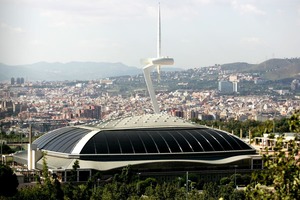
The largest of the many buildings that were constructed for the 1992 Summer Olympics in Barcelona. It is a huge indoor sports arena with a capacity of almost 18,000 people! It is the largest indoor arena in Spain. It now hosts various cultural, sporting events and concerts.
Olympic Stadium (Estadio Olímpico de Montjuic)
A stadium with a rich long history, which begins with its construction in 1929 for the International Exhibition.  In 1992 it was completely reconstructed for the Olympic Games. It's a magnificent stadium. There are great concerts here! You must visit it if you are in Barcelona.
In 1992 it was completely reconstructed for the Olympic Games. It's a magnificent stadium. There are great concerts here! You must visit it if you are in Barcelona.
Olympic Ring and Europe Square
Anillo Olímpico. This is the neighbourhood of Barcelona where the main venues for the 1992 Olympic Games are located. Quite a large part of Europe Square is occupied by a sculptural composition in the form of concrete cylinders - "Change". The Telecommunications Tower of Montjuic (Torre de Comunicacions), a futuristic masterpiece of the famous architect Santiago Calatrava, also called the Calatrava Tower and the Telefónica Tower, is one of the main attractions of Barcelona and Montjuic. A must-see place for tourists!
Poble Espanyol
Spanish village - translated from the Catalan language. This place was originally planned as an exhibition for six months. This unusual open-air museum is now considered a Barcelona landmark. It is an area of 49,000 m² on which buildings typical of the 15 autonomous communities of Spain have been erected. It is a very interesting place to stroll around. The colourful objects allow you to visualise the life and everyday life of people from almost every corner of Spain. Entrance to the village is paid - 13,50€ for adults and 9€ for children from 3 to 12 years old. But if you want to visit this place, you need to find out in advance on the official website if there are any events there. Otherwise, you will pay for the entrance and there will be nothing to see.
National Museum of Art of Catalonia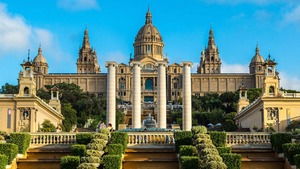
Museu Nacional d'Art de Catalunya. MNAC acronym. National Museum, with a collection of Catalan and Romanesque paintings, art from the 10th to the 20th centuries, as well as many Renaissance masterpieces. The museum building has a privileged location at the foot of Montjuic Mountain.
Magic Fountain (Fuente Mágica)

A "magic" fountain at the foot of Montjuic, opposite MNACa. It was built in a futuristic style for the 1929 World's Fair. A beautiful and picturesque place with stunning shows that combine water, colours and music. It is Barcelona's most famous fountain. Children love to watch the "dancing" fountains, and adults will enjoy the show too.
It can be seen in summer from Wednesday to Sunday from 21:30 to 22:30, and in winter from Thursday to Saturday from 20:00 to 21:00. But it's better to watch the schedule on the official website, as there are often cancellations of the show. Last time it was cancelled due to drought conditions.


 English
English  Español
Español  Русский
Русский